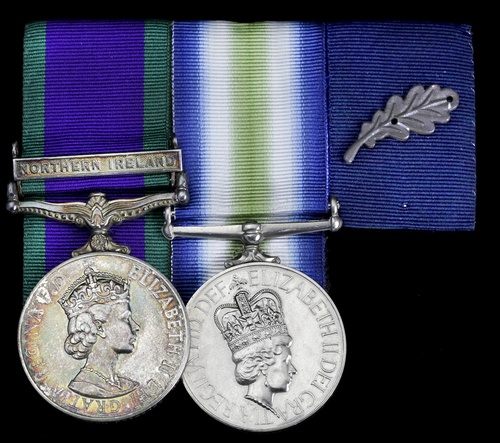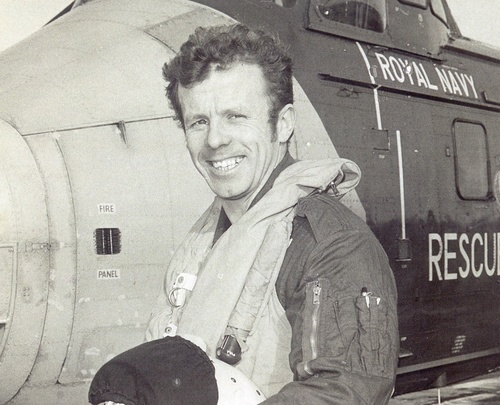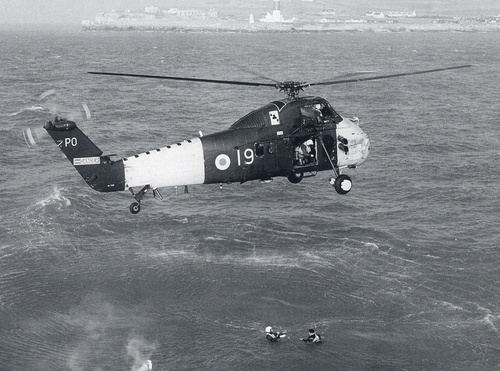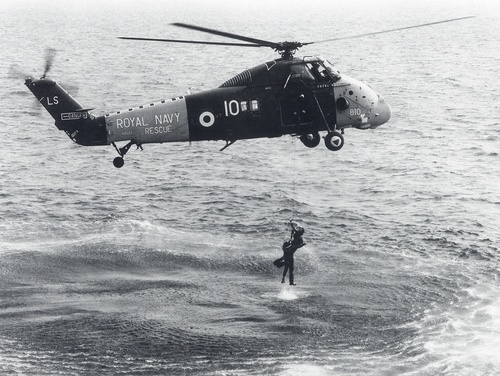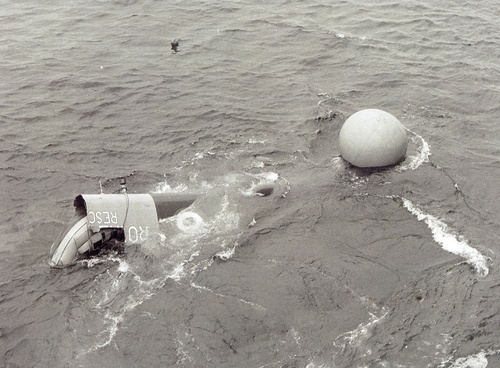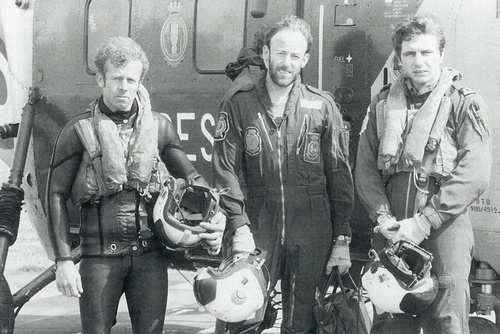Auction: 18003 - Orders, Decorations and Medals
Lot: 604A
A fine Queen's Commendation for Bravery pair awarded to Chief Petty Officer D. E. 'Bomber' Brown, Royal Navy, who initially served as a Navigator and Missile Aimer in Wasp helicopters before becoming a Search and Rescue Diver
His active service career encompassed operations in Northern Ireland - as Commando Aircrew in support of the Royal Marines - and valuable service lent in 845 Squadron during the Falklands War
But it was for his gallant role in search and rescue missions that he won two notable distinctions, namely the R.H.S. Testimonial on Vellum for rescuing a pregnant woman at the mouth of Chichester Harbour in a Force 8 storm, and the Queen's Commendation for Bravery for saving the life of a seaman trapped in an upturned dredging barge in the Western Solent
General Service 1962-2007, 1 clasp, Northern Ireland (CPOACMN D E Brown F974315J RN); South Atlantic 1982 (CPOACMN D E Brown F974315J 845 Sqn), together with blue riband with oak leaf representative of the Queen's Commendation for Bravery, mounted as worn, the second with officially re-impressed service number and unit, nearly extremely fine (2)
Queen's Commendation for Bravery London Gazette 24 February 1981.
Royal Humane Society Testimonial on Vellum 7 January 1975.
David Edward 'Bomber' Brown, who was born on 10 July 1939, commenced his career at H.M.S. Osprey and qualified as a Ship's Diver at Drake's diving school in August 1968. Posted to 771 Squadron as a crewman at Portland in February 1969, he was noted on 29 Rating Aircrew Course as 'a very keen rating who has worked hard'.
He subsequently gained a 1st Class pass on the No. 5. A.S. 12 Missile Aimers' Course (Wasp helicopters) and joined 829 Squadron, flying Wasp helicopters; after a 7-day, 6-night flying assessment in January 1972, the Squadron Commander remarked in his log book, 'a highly professional and enthusiastic aircrewman'. Such qualities would prove invaluable both in wartime and in peacetime, but from the sheer number of flights evident in Brown's flying log books, one should add 'tenacity' and 'endurance'. He qualified S.A.R. Diver at Osprey in February 1973.
Early rescue sorties
On 8 August 1973, Brown joined a 45-minute S.A.R. sortie from Daedalus, based at Lee-on-the-Solent, flying as crewman aboard a Whirlwind Mk. 9 helicopter in search of a Russian seaman; his log book fails to note the outcome. That same day, he conducted four further searches, including two separate flights for missing people in dinghies. From late 1973 to 1975, his working life involved almost daily training exercises and operational flights to rescue people. These included helping those trapped at the base of cliffs (some with broken legs), water skiers in distress, children caught out by the tides and those trapped in overturned yachts, whilst all the time gaining knowledge of the south coast and practising different rescue scenarios.
Award of the Royal Humane Society Testimonial on Vellum
On 23 September 1975, Brown acting as diver in the duty S.A.R. Helicopter at Daedalus. He was scrambled to a private yacht, the 40-foot John Lewis Partnership owned Sabeena II, which had been dismasted at the mouth of Chichester Harbour in a Force 8 which was throwing up 10-foot waves. The subsequent debris had fouled the propeller, leaving the yacht helpless and entirely at the mercy of the storm. The yacht's crew and passengers, including a five-month pregnant 23-year-old woman, Mrs. Mary North, were becoming increasingly distressed and, as the helicopter arrived on the scene, the lady and the six men began to leap into the sea in order to be picked up. Brown immediately winched himself down and headed for Mrs. North, who was first in the water and seemed in trouble. Signalling to the crew above to winch the pair out, it was at this moment that the winch jammed and both lay helpless in the sea; Brown was forced to disconnect himself from the winch cable and keep the pair afloat for as long as possible. For his bravery in supporting Mrs. North for between 15 and 20 minutes - and undoubtedly saving her from drowning - he was awarded the R.H.S. Testimonial on Vellum; having been brought ashore by the Chichester Harbour patrol craft, Brown entered a single word in his relevant flying log book entry: 'Close'.
Four days later, Mrs. North's husband wrote to Brown to thank him for 'courageously helping my wife in the sea. Please accept the enclosed in appreciation for your help - the best thing we know to keep out the cold!'
Remarkably, it appears that he had already conducted another S.A.R. call to Bournemouth on the same flight, although the outcome was less happy, his relevant entry stating: '1 body'.
Transferring to the S.A.R. Flight aboard Ark Royal, Brown found himself in the drink for a second time on 17 September 1975 when his Wessex helicopter was forced to make a 'controlled ditching' in Lyme Bay following the illumination of an engine fire warning light; with the tables turned, this time it was Lieutenant A. C. T. Tate, Commander J. Worth, Leading Aircraftsman P. Hope, and Brown, who required rescue from the S.A.R.; the crew escaped unharmed, which is more than can be said for their Wessex helicopter XP 112, which was lost to the depths.
Following Ark Royal, Brown transferred to the tribal-class frigates Tartar and Gurkha, from which he operated in Wasp helicopters. In the latter ship, he spent time monitoring the Souffriere Volcano in the West Indies and assisting with scientific studies.
Naked ambition
In 1979 he decided to return to search and rescue and trained as an S.A.R. aircrew diver with 781 Squadron. He subsequently undertook a wide variety of rescues, including a light aircraft which had crashed into the sea at Bembridge, boat fires, assisting a person who had suffered a heart attack, and a woman in difficulty at Lulworth. Some would be more memorable than others, but one which caught the attention of the local press involved a nudist from the Midlands who became stranded on rocks close to the cliff at Blackgang:
'Two hundred feet above him, Mr. Richard Young was tending a vegetable patch on the clifftop when an unexpected sound reached his ears.
"It sounded just like someone blowing a police whistle," he said.
He peered over the cliff edge and realised that the man was blowing a whistle as an emergency signal. Mr. Young raised the alarm and, within minutes, a search and rescue helicopter arrived from H.M.S. Daedalus, Lee-on-Solent.
The helicopter put down a diver who was startled to find that the dinghy sailor, by now clinging to his capsized craft, was "absolutely naked, apart from his lifejacket."
The distressed mariner was put ashore at a nearby sheltered cove popular among naturists. His dinghy was taken in tow by a fishing boat.
Commented a helicopter crewman: "It is just as well he did not manage to whistle up the wind - he might have died of exposure." '
Queen's Commendation for Bravery
On 11 May 1980, Brown found himself in an altogether more dangerous and serious predicament. At 11 a.m. that morning, an 80-foot long barge filled with sediment, dredged from an underwater trench in the Solent, capsized one mile north-east of Hurst Castle, as it was being towed from Lymington to the Needles. Two men were aboard at the time and one, Stephen Devereux, was trapped underwater in an air pocket in the living quarters, in what was described as 'rough weather'.
Scrambled from Daedalus, Brown and Leading Air Crewman John Spencer, who was just 22 years of age, arrived on the scene in a Wessex helicopter piloted by Lieutenant Bill Sample, and decided to both use their diving skills to extricate the trapped man:
"It looked like a long job. We had other divers available, so it would have been silly not to use them," said a Daedalus spokesperson.
On reaching the upturned barge, Spencer and Brown dived underwater and began to look for an entrance point. Devereaux in the meantime had picked up a saucepan and started banging on the hull. The rescuers banged back. In an interview with the local newspaper, Spencer recalled the event in detail:
"I managed to find a hatch which I had to smash open with a hammer in order to get in. It was pitch dark inside, and as I had no torch I had to feel my way inside to swim up and reach the trapped man. I tried to calm him down but he was scared. The water level was rising quite quickly.
I had to leave him for a while to get another breathing set, and returned with Chief Air Crewman Brown. Although we had very little space to work in, the man began to build up some courage. Brown got him free."
For Brown, Devereaux and Henderson, the latter of whom had been picked up by a fishing boat, the two-hour ordeal was nearly over, but for the youngest on the scene it was a close-run thing:
"I gave them about a minute to get clear so I would not worry the man by making things complicated, but when I tried to follow them some of my equipment got caught up somewhere, and I was blocked in. It took me some time to wriggle clear. It was pretty scary for a time."
For his part in rescuing Devereaux, Brown was awarded the Queen's Commendation for Bravery. Devereux made clear his feelings to the two men, publicly announcing in the local press, "You were magnificent."
By early 1981, Brown had over 1500 hours of flight time recorded in his log books and was becoming increasingly active on diving drops; many would involve practise exercises where he was involved in recovering makeshift 'weighted-diver' bodies from the seabed. Others would bring home the seriousness and sadness involved in his duty, including a search for a car with two bodies which had plunged from the jetty in Southampton dock.
Northern Ireland and the Falklands
Temporarily ending his association with S.A.R., Brown decided to retrain as Commando Aircrew in support of the Royal Marines. Joining 845 Squadron at Yeovilton, Somerset, Brown was responsible for 'very low-level map reading' in a Wessex Mark 5 helicopter. His flying log book notes a large number of 'mountain flying' sorties in the skies above Northern Ireland, including night troop movements and tasking over Armagh and Bessbrook.
In 1982, Brown served in the Falklands War and was involved in numerous transits between the islands and ships of the Task Force; on 12 May 1982, he was part of a P.O.W. move to the Tidespring, and on 23 June he assisted with a CASEVAC from the British Trent. Thereafter, Brown served with 845 Squadron at Ascension, but he clearly missed S.A.R. and decided to return as Chief in charge of the flight at Daedalus.
Return to Search and Rescue
The mid-1980s saw Brown return to search and rescue duties, work that included wayward windsurfers, sailors overboard, MEDEVACs, boats on fire, lost divers and assisting with those suffering from the bends.
By 1992, Brown had left the Royal Navy and taken up an S.A.R. role with Bristow Helicopters in the North Sea, covering the Brent Field, 140 miles east of the Shetlands. It was a role which he would carry out for the final 13 years of his career and it was aboard a Bell 212 helicopter that Brown conducted one of his most challenging rescues - an incident that became known as the 'Cormorant Alpha tragedy'.
On 14 March 1992, a Super Puma helicopter crashed on a short flight from Shell's Cormorant Alpha platform to the accommodation barge Safe Supporter. Eleven men perished within a short period of time, but six survivors lay helpless in the water, amidst 40-foot waves, awaiting the arrival of the Bell 212, together with three winchmen, Brown, Cockerell and Boulton. The official inquiry held at Aberdeen some time later heard testimony of the desperate scenes:
'The waves were so high, the pilot had to manoeuvre the small Bell 212 up and down to avoid being hit by walls of water.'
'Looking ahead, sometimes we could actually see the waves above the helicopter or at least in line with it.'
One of the winchmen, Michael Cockerell, had to be pulled back into the helicopter after being hit by a massive wave and almost knocked unconscious. Close to tears, he told the enquiry how one of the men whom he lifted from the sea fell back in only a few feet from the helicopter: 'Three of the helicopter crew were unable to hold onto him because his survival suit was filled with water and he resembled a "Michelin Man."'
Brown was lowered and pulled up four survivors. He also had the grim task of picking up the body of the stricken aircraft's co-pilot. Exhausted and in extreme danger, they returned to the Safe Gotha flotel. Two further men were rescued by another crew.
Following the inquest, Brown and the rest of 'call sign Rescue 145' were commended by The Viscount Goschen, Minister for Aviation and Shipping, in February 1995.
It is likely that Brown retired from Bristow helicopters and S.A.R. around 1997.
Sold with the following original documentation:
(i)
R.N. Aircrew Flying Log Book, privately re-bound, with gilt tooled inscription to 'D. E. Brown' and covering the period 21.2.1969-11.5.1980; incorporating original Underwater Escape Training SMAC 35B Certificate, 6 October 1978; Aircrew Escape Training Certificates (2), H.M.S. Daedalus 1974 & R.N. Safety Equipment and Survival School 1973.
(ii)
R.N. Aircrew Flying Log Book (Form S 1175 type), covering the period 11.4.1980-05.07.1984.
(iii)
R.N. Divers Log Book (Form S. 1627 type), covering the period 23.8.1968-14.6.1984; a thorough account, detailing training exercises and a range of underwater tasks.
Together with a large archive of copied newspaper reports and copied photographs of the recipient, helicopters flown, and key moments - including the remains of Brown's ditched Wessex helicopter; copied letters of thanks; photocopies of original R.H.S. Vellum and Commendation certificates.
Subject to 20% VAT on Buyer’s Premium. For more information please view Terms and Conditions for Buyers.
Sold for
£1,500

